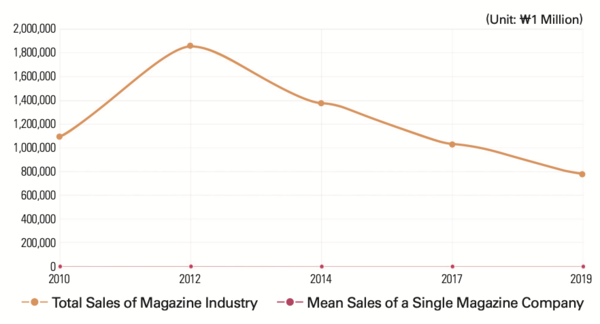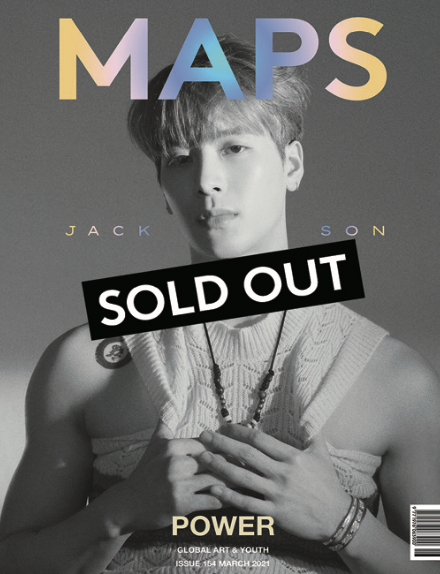In July, the Korea Magazine Association held its magazine publishing seminar abroad for the first time in its 61 years of existence. The association’s unusual action indicated the need for valuable foreign ideas to revive the Korean magazine industry. Since when did magazines, the icons of popular culture mass media in the 1990s, get into such a position? The Sungkyun Times (SKT) aims to seek the factors that crashed the magazine industry, the possible solutions, and its future.
Today's Magazine Industry
-Planar Figure of the Industry
Magazines are regularly published booklets designed to spread reports and comments on areas of politics, economics, and culture and must be published once a month or less. The magazine industry’s distribution procedure is unique, as it varies depending on the magazine company’s platform and size. Paper magazine companies with a substantial scale and a solid readership use a direct distribution process. In other words, the company sends its magazine to the readers directly via post. Smaller magazine companies distribute their magazines to bookstores or sign contracts with distributors who sell the products to local stores. The allocation of webzines is simple because the content gets delivered straight to the readers through an online magazine platform. The profit system comprised of three main parts is another important factor of the magazine industry. The profits consist of actual magazine sales, advertisement fees, and content profits earned from using content and copyrights. Magazine sales and advertisement fees cover most of the industry’s profits, while content sales income is minimal. Hence, the magazine’s profits are directly related to its quality.
-Ups and Downs of the Industry
Korea’s first magazine was Sonyeon, which was published by Choi Nam-seon in 1908 with the aim of enlightenment. The early stages of Korean magazines had political and nationalistic aspects, especially during the Japanese colonial period. After the liberation from Japan, the magazine industry began to expand rapidly. With the beginning of democratization and the development of freedom of speech, the magazine industry met its golden era in the 1980s. According to the Encyclopedia of Korean Culture, magazines increased from 2,241 to over 3,000 from 1987 to 1988. However, the magazine industry faced its downfall in the 2010s. According to 2020 statistics by the Korea Press Foundation, the net income of the magazine industry from 2012 to 2019 decreased by over ₩1 trillion. Predicting the industry’s collapse, the Korean government enacted the Magazine Promotion Act in 2008 to nurture professionals in the magazine market and protect the rights of readers. Unfortunately, even these governmental efforts could not prevent the defeat of the magazine industry.

Why Did the Industry Break Down?
-Reduction of Demand
Previously, magazines played the role of mass media and delivered information to the public with great authority. However, the increasing supply of rival media outlets due to the evolution of technology naturally reduced the demand for magazines. In the past, the magazine industry’s production and profit structure developed through efficient distribution using trains and trucks, which facilitated the industry to spread its content effectively and expand its business. However, the meteoric development of the internet in 1994 provoked the rise of rival media platforms. Moreover, the advent of smartphones raised the quality and convenience of internet content, further threatening the magazine industry. The growth of online platforms and new media changed the distribution structure in the market and put the magazine market in the rear end. In 2018, four out of eight magazines published by JTBC Plus, affiliated with the JoongAng Ilbo, closed. Ceci, a symbolic women’s magazine in Korea, was one of the magazines that met their end. To tide over the crisis, the magazine industry entered the webzine business but failed to gain both profitability and popularity. This is because webzines that displayed only texts and photos had no distinct features in their content compared to other online platforms such as YouTube. For example, the Village Voice, New York’s representative newspaper and cultural critic, closed in 2018 due to failure in its online-centered strategy.
-Magazine or Billboard?
Another contributing factor to the magazine industry’s crisis is its profit system. With the recent development of technology, magazines began to earn more profits from subscriptions and magazine sales due to reduced production costs. Still, the magazine industry heavily relies on revenue from advertisements. According to 2022 research by the Korea Press Foundation, profit from advertisements was 32.2%, while income from content sales was only 2.9%. Therefore, if the sales of a magazine fail to reach the goals, the editors are compelled to insert more advertisements. Then, the magazine’s quality will decrease, eventually affecting sales negatively and inducing a vicious cycle. Lee Dong-min (Sophomore, Department of Psychology), who used to be a fan of magazines, commented, “The biggest reason I do not buy magazines these days is because they are full of advertisements.” With the development of the internet, many corporations started to display their advertisements on websites rather than in offline magazines. As a result, the payment fee for magazine advertisements decreased, causing the magazine companies to suffer from production cost shortages. In addition, the webzine business also encountered problems with advertising. Since webzines get displayed on screens, the advertisements tend to exhaust the readers more than paper magazines, leading to a decrease in demand for them.
Lightbulb for the Industry
-Transformation of Magazines
The magazine industry must face its limitations as a mass media, acknowledge the changing social atmosphere, and transform into an exclusive media form for specific readers. Instead of aiming for the entire public, the industry can focus on producing unique content that targets specific audiences. For instance, MAPS , a Korean youth culture and art magazine, attracted readers by dealing with minor street culture and youth artists who deliver distinctive messages. The Editor-in-Chief of MAPS , Ryu Do-yeon, explained in an interview with SKT, “MAPS is a local magazine which has been successful in the market for over 17 years, and as the Editor-in-Chief I am very proud of this accomplishment.” Moreover, the magazine industry can concentrate more on its content quality than seeking large sales and marketing. For example, Vogue boldly gave up its monthly publication process and started publishing paper copies only twice a year to focus on its quality. Moreover, the industry must adapt to the advancement of technology and apply new techniques to its magazine platforms to entertain its readers and compete with other online media platforms. Again, Vogue used big data to create a content plan based on its readers’ preferences and search records. Based on the content plan, Vogue chose its cover model to be V from BTS and sold out all six types of editions on the online commerce platform Ktown4u.

-Selling Contents, Not Ads
The magazine industry can solve its structural problems by transforming its target readers, focusing more on the quality of content, and becoming collectible. By enhancing its own value, the industry can earn more profit through sales of magazines, reducing the dependency on advertisement fees. A German fashion magazine 032c is an example of this strategy. The magazine launched a fashion brand, released exclusive quality clothing, and held runways to increase the brand value of 032c. By raising the brand value, the company stimulated the consumer’s urge to possess products with the name 032c and successfully sold its magazines. These attempts will allow the magazine market to escape the pressure of advertisement profits and attract readers with unique content. Furthermore, magazines can attempt to transform advertisements into entertaining forms of content. For instance, Vogue in 2014 captured the hearts of its readers by displaying sensational advertisements of dressing models as Barbie dolls and packaging them using luxury brand products. The webzine industry can also use this strategy by utilizing its online platform and by further displaying unique and creative advertisements that can entice readers.

Magazines have a unique value that no other form of media can replace. Numerous journalists and social critics, therefore, showed compassion for the downfall of magazines. However, from an economic perspective, the magazine industry must undergo a transformation for a successful revival. Kingos should take regard in the efforts which the magazine industry puts in for its rejuvenescence.
